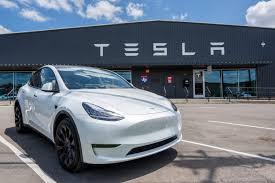Will the car sell itself? Perhaps. But some potential buyers will see the Musk association with Tesla as reason to look elsewhere.
One of the relatively new areas of communication research is the study of how a company or individual responds to a damaged brand. It is an interesting problem to tackle because there are so many corporate vulnerabilities. There may be a publicized problem with a product. In other cases the producer’s recent words or deeds are the focus. In the case of damage to the Tesla car brand, the challenge is obviously with CEO Elon Musk, who is about as popular now as the idea of dental surgery. Musk signed on to Donald Trump’s chaotic effort to dismember the federal establishment by firing thousands of career federal workers. Weeks ago he brandished a chain saw in the Oval Office to dramatize what he and his DOGE staff planned to do in cutting jobs and federal agencies like OSHA and NOAA. The photo op gave new meaning to the metaphor of being tone deaf. The saw suggested how indelicate and insensitive the process would be. News coverage has been filled with dazed workers fired on the spot, and the apparent pleasure Musk seemed to receive by depriving public servants of their employment and citizens of needed services. In rhetorical terms, for many, Tesla has become a convenient synecdoche, a symbol for a whole cluster of negative feelings associated with the administration. Dealers and automobiles are now easy targets for protesters.
 A recent Newsweek poll notes that forty-nine percent of respondents said they view Musk unfavorably, compared to only 39 percent who view him positively. Those are not good numbers for a high profile head of a company who has taken a detour to help fire some 140 thousand federal workers.
A recent Newsweek poll notes that forty-nine percent of respondents said they view Musk unfavorably, compared to only 39 percent who view him positively. Those are not good numbers for a high profile head of a company who has taken a detour to help fire some 140 thousand federal workers.
The brand Musk nurtured as uniquely his has paid the price in terms of a huge drop in the value of Tesla stock and car sales. In Europe, the losses have nearly been total. And many owners in the U.S. have since sold their cars. Many of those who remain have grown uneasy driving their Teslas in areas where hostility toward the administration is white hot.
 If these problems aren’t difficult enough for the brand, they have been made worse by Musk’s seemingly pro-Fascist and gestures and statements, confirmed recently by his overt support of Germany’s far right political parties. In the 1920s Henry Ford similarly flirted with German Fascists and virulent antisemitism. But news about Musk has been more overtly available and negative.
If these problems aren’t difficult enough for the brand, they have been made worse by Musk’s seemingly pro-Fascist and gestures and statements, confirmed recently by his overt support of Germany’s far right political parties. In the 1920s Henry Ford similarly flirted with German Fascists and virulent antisemitism. But news about Musk has been more overtly available and negative.
For all of these reasons the former Cinderella brand now seems to be in deep trouble. Investment specialist and former enthusiast Dan Ives cites the ongoing Tesla problems around the world as a “dark black cloud” over the company’s stock, which is now down 40 percent this year. The future is further clouded by high-flying new EVs from BYD, Nio, XPeng, and other Chinese automakers. So far, these lower priced competitors are tariffed out of the U.S. market. But Tesla now has other car makers with their own competitive products. One auto analysist has compared the storm of controversy that has overtaken Musk to an F5 tornado.
Salvaging a brand
People who focus on crisis communication look first at earlier cases, like the storm of news about Johnson & Johnson’s painkiller brand Tylenol in 1982. It was hit by a literal life-and-death crisis when seven people died after taking contaminated Extra Strength Tylenol. J and J saved the brand by being transparent about what had happened, and reformulating Tylenol into a tamperproof pill.
Other brands have not been so lucky and were abandoned because of various accidents and flaws that got extensive coverage. If you are old enough, think of the Edsel, the Ford Pinto, the Chevrolet Corvair, or the Oil Spill of the tanker in 1989. More recently we witnessed misuse of Facebook personal data by Cambridge Analytica in 2016.
Notwithstanding question’s about Musk’s character, will the Tesla continue to sell itself? Perhaps. But some potential buyers will see Musk’s association involvement as enough to look elsewhere. Then, too, the company is not known for thoughtful attention to customer concerns and needs.
Some potential buyers won’t care, using the logic that they are buying the car, not its creator. If Musk removed himself from Tesla’s management, that would probably help.
The usual road to recovery usually begins with a full apology for past actions. Theories of brand repair lean heavily on honest disclosures of mistakes. Helen Edwards, an expert in marketing, has additional and familiar suggestions:
-
Keep the name.
-
Study histories of Tylenol and other restored brands.
-
Make product service a top priority.
-
Refresh your communications with your customers.
-
Give yourself 10 to 15 years to recover.
In the end, Musk has one deep liability and one significant strength. The strength is that he seems to have boundless wealth, which can carry even as massive a business along for a while. The weakness is equally clear. If a person has the kind of character that tends to turn people off, in this hothouse digital age that is something that is not easily changed, even if you own one of the platforms.
![]()
